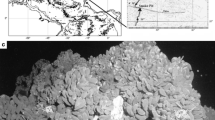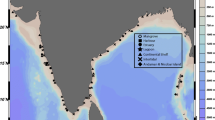Abstract
Samples taken at two stations in the northern and southern parts of the Scotia Arc, at depths of 277 and 307 m, respectively, were analysed for metazoan meiofauna with special attention to the nematodes. Identification to species level was performed for two closely related subdominant nematode genera (Desmodora and Desmodorella) in samples from the two Scotia Arc stations and in other available samples from adjacent areas (Magellan Region, Drake Passage, Weddell Sea). Seven Desmodora species and three Desmodorella species were found, of which, respectively five and two species are new to science. The Scotia Arc stations show relatively high densities and average diversity on meiofauna and nematode level compared to adjacent areas. The distribution patterns of the various Desmodora and Desmodorella species suggest the Scotia Arc as a shallow bridge and a possible exchange route for meiofauna between the Antarctic and South America, especially since these species seem to be constrained by water depth.






Similar content being viewed by others
References
Angel MV, Fasham MJR (1983) Eddies and biological processes. In: Robinson AR (ed.) Eddies in marine science. 1983 series: Topics in atmospheric and oceanographic sciences. Springer, Berlin Heidelberg New York
Arntz WE, Brey T (2003) The expedition ANTARKTIS XIX/5 (LAMPOS) of RV “Polarstern” in 2002. Berichte zur Polar- und Meeresforschung 462
Arntz WE, Brey T, Gallardo VA (1994) Antarctic zoobenthos. Ocean Mar Biol: Ann Rev 32:241–304
Arntz WE, Gutt J, Klages M (1997) Antarctic marine biodiversity: an overview. In: Batagli B, Valencia J, Walton DHW (eds) Antarctic communities: species, structure and survival. Cambridge University Press, Cambridge, pp 3–14
Barker PF (2001) Scotia Sea regional tectonic evolution: implications for mantle flow and palaeocirculation. Earth Sci Rev 55(1, 2):1–39
Barker PF, Burrell J (1982) The influence upon Southern Ocean circulation, sedimentation, and climate of the opening of the Drake Passage. In: Craddock C (ed) Antarctic geoscience, University of Wisconsin Press, Madison, pp 377–385
Barron GL (1977) The nematode-destroying fungi. Topics in mycobiology: 1. Canadian Biological Publications, Guelph
Bathman U, Fischer G, Muller PJ, Gerdes D (1991) Short-term variations in particulate matter sedimentation off Kapp Norvegia, Weddell Sea, Antarctica: relation to water mass advection, ice cover, plankton biomass and feeding activity. Polar Biol 11:185–195
von Bodungen B, Smetacek VS, Tilzer MM, Zeitzschel B (1986) Primary production and sedimentation during spring in the Antarctic Peninsula region. Deep Sea Res Pt I 33:177–194
Brey T, Klages M, Dahm C, Gorny M, Gutt J, Hain S, Stiller M, Arntz WE (1994) Antarctic benthic diversity. Nature 368:297
Brey T, Dahm C, Gorny M, Klages M, Stiller M, Arntz WE (1996) Do Antarctic benthic invertebrates show an extended level of eurybathy? Antarctic Sci 8(1):3–6
von Bröckel K (1985) Primary production data from the south-eastern Weddell Sea. Polar Biol 4:75–80
Bussau C (1993) Taxonomische und ökologische Untersuchungen an Nematoden des Peru-Beckens. PhD thesis, University Kiel, Kiel
Chen G (1999) Ecology and systematics of the meiofauna and nematode communities in the Strait of Magellan and the Beagle Channel (Chile). PhD thesis, Ghent University, Belgium
Clarke A, Crame JA (1992) The Southern Ocean Benthic fauna and climate change—a historical perspective. Philos T Roy Soc B 1285:299–309
Clarke A, Johnston NM (2003) Antarctic marine benthic diversity. Ocean Mar Biol: Ann Rev 41:47–114
Clarke A, Barnes DKA, Hodgson DA (2005) How isolated is Antarctica? Trends Ecol Evol 20(1):1–3
Clasing E (1980) Postembryonic Development in Species of Desmodoridae, Epsilonematidae and Draconematidae. Zool Anz 204(5, 6):337–344
Cobb NA (1917) Notes on nemas. Contrib Sci Nematol 5:117–128
Commito JA, Tita G (2002) Differential dispersal rates in an intertidal meiofauna assemblage. J Exp Mar Biol Ecol 268:237–256
Coull BC (1988) Ecology of the marine meiofauna. In: Higgins RP, Thiel H (eds) Introduction to the study of meiofauna. Smithsonian Institution Press, London, pp 18–38
Crame JA (1999) An evolutionary perspective on marine faunal connections between southernmost South America and Antarctica. Sci Mar 63(Suppl 1):1–14
De Mesel I, Lee HJ, Vanhove S, Vincx M, Vanreusel A (2006) Species diversity and distribution within the deep-sea nematode genus Acantholaimus on the continental shelf and slope in Antarctica. Polar Biol (in press)
Deprez T, et al (2005) NeMys. World Wide Web electronic publication. http://www.nemys.ugent.be, version (10/2005)
Figueiras FG, Estrada M, López O, Arbones B (1998) Photosynthetic parameters and primary production in the Bransfield Strait: relationships with mesoscale hydrographic structures. J Mar Syst 17:129–141
Fonseca G, Vanreusel A, Decraemer W (2006) Taxonomy and biogeography of Molgolaimus Ditlevsen, 1921 (Nematoda: Chromadoria) with reference to the origins of deep-sea nematodes. Ant Sci (in press)
Heip C, Vincx M, Smol N, Vranken G (1982) The systematics and ecology of free-living marine nematodes. Helminthol Abs Ser B, Plant Nematol 51(1):1–31
Heip C, Vincx M, Vranken G (1985) The ecology of marine nematodes. Ocean Mar Biol: Ann Rev 23:399–489
Heip C, Herman P, Soetaert K (1998) Indices of diversity and evenness. Océanis 24(4):61–87
Herman RL, Dahms HU (1992) Meiofauna communities along a depth transect off Halley Bay (Weddell Sea Antarctica). Polar Biol 12:313–320
Higgins RP, Thiel H (1988) Introduction to the study of meiofauna. Smithsonian Institution Press, London
Hill MO (1973) Diversity and evenness: a unifying notation and its consequences. Ecology 54:427–432
Jensen P (1978) Revision of Microlaimidae, erection of Molgolaimidae fam.n., and remarks on the systematic position of Paramicrolaimus (Nematoda, Desmodorida). Zool Scr 7:159–173
Jensen P (1988) Nematode assemblages in the deep-sea benthos of the Norwegian Sea. Deep-Sea Res Pt I 35(7):1173–1184
Knox GA (1994) The biology of the Southern Ocean. Studies in polar research. Cambridge University Press, Cambridge
Korb RE, Whitehouse M (2004) Contrasting primary production regimes around South Georgia, Southern Ocean: large blooms versus high nutrient, low chlorophyll waters. Deep-sea Res Pt I 51:721–738
Lambshead PJD (1993) Recent developments in marine benthic biodiversity research. Océanis 19(6):5–24
Lawver LA, Gahagan LM (2003) Evolution of Cenozoic seaways in the circum-Antarctic region. Palaeogeogr Palaeoclimatol Palaeoecol 198(1–2):11–37
Luyten C (1999) Meiofauna van Antarctica: structurele en trofische aspecten. Licentiate thesis, Ghent University
Manachini B (1997) Biodiversity of Nematoda assemblages in the Antarctic sea bed. MSc thesis, Ghent University
Palmer MA (1990) Understanding the movement dynamics of a stream-dwelling meiofauna community using marine analogs. Stygologia 5(2):67–74
Pastor de Ward CT (1988) Nematodes Marinos de la Ría Deseado (Desmodoroidea): Desmodoridae, Draconematidae), Santa Cruz, Argentina. VII. Physis (Buenos Aires), Seccion. A. 46:61–72
Platt HM, Warwick RM (1998) Freeliving marine nematodes. Part II Chromadorids. Synopses of the British Fauna (New Series) 53. The Linnean Society and The Estuarine and Coastal Sciences Association, London
Soetaert K, Heip C (1990) Sample-size dependence of diversity indices and the determination of sufficient sample size in a high-diversity deep-sea environment. Mar Ecol Prog Ser 59:305–307
Soetaert K, Heip C (1995) Nematode assemblages of deep-sea and shelf break sites in the North Atlantic and Mediterranean Sea. Mar Ecol Prog Ser 125:171–183
Soltwedel T (2000) Metazoan meiobenthos along continental margins: a review. Prog Oceanogr 46:59–84
Thomson MRA (2004) Geological and palaeoenvironmental history of the Scotia Sea region as a basis for biological interpretation. Deep-Sea Res 51(Pt II):1467–1487
Tita G, Vincx M, Desrosiers G (1999) Size spectra, body with and morphotypes of intertidal nematodes: an ecological interpretation. J Mar Biol Assoc UK 79:1007–1015
Ullberg J, Ólafsson E (2003) Free-living marine nematodes actively choose habitat when descending from the water column. Mar Ecol Prog Ser, 260:141–149
Vanaverbeke J, Soetaert K, Heip C, Vanreusel A (1997) The metazoan meiobenthos along the continental slope of the Goban Spur (NE Atlantic). J Sea Res 38:93–107
Vanhove S (1997) Antarctic sublittoral meiofauna: focus on the ecology of free-living marine nematodes. PhD thesis, Ghent University, Belgium
Vanhove S, Wittoeck J, Desmet G, Van den Berghe B, Herman RL, Bak RPM, Nieuwland G, Vosjan JH, Boldrin A, Rabitti S, Vincx M (1995) Deep-sea meiofauna communities in Antarctica: structural analysis and relation with the environment. Mar Ecol Prog Ser 127:65–76
Vanhove S, Lee HJ, Beghyn M, Van Gansbeke D, Brockington S, Vincx M (1998) The metazoan meiofauna in its biogeochemical environment: the case of an Antarctic coastal sediment. J Mar Biol Assoc UK 78:411–434
Vanhove S, Arntz W, Vincx M (1999) Comparative study of the nematode communities on the southeastern Weddell Sea shelf and slope (Antarctica). Mar Ecol Prog Ser 181:237–256
Vanhove S, Beghyn M, Van Gansbeke D, Bullough LW, Vincx M (2000) A seasonally varying biotope at Signy Island, Antarctic: implications for meiofauna structure. Mar Ecol Prog Ser 202:13–25
Vanhove S, Vermeeren H, Vanreusel A (2004) Meiofauna towards the deep South Sandwich Trench (750–6300 m). Deep-Sea Res Pt II 51:1665–1687
Vanreusel A, Vincx M, Van Gansbeke D, Gijselinck W (1992) Structural analysis of the meiobenthos communities of the shelf break area in two stations of the gulf of Biscay (N.E. Atlantic). Belg J Zool 122(2):185–202
Vermeeren H (2002) Biogeografie van Antarctische diepzeenematoden: species turn-over in dominante genera van de familie Chromadoridae. Licentiate thesis, Ghent University, Belgium
Vermeeren H, Vanreusel A, Vanhove S (2004) Species distribution within the free-living marine nematode genus Dichromadora in the Weddell Sea and adjacent areas. Deep-Sea Res Pt II 51:1643–1664
Verschelde D, Gourbault N, Vincx M (1998) Revision of Desmodora with descriptions of new desmodorids (Nematoda) from hydrothermal vents of the pacific. J Mar Biol Assoc UK 78:75–112
Vincx M (1996) Meiofauna in marine and fresh water sediments. In: Hall GS (ed) Methods for the examination of organismal diversity in soils and sediments. IUBS Series of Methodology Handbooks, CAB International, University Press, Cambridge, pp 214–248
Wenthworth CK (1922) The Wenthworth scale of grain size for sediments. J Geol 30:381
Wieser W (1959) The effect of the grain size in the distribution of small invertebrates inhabiting the Beaches of Puget Sound. Limnol Oceanogr 4:181–194
Acknowledgements
We are very much indebted to the Alfred-Wegener Institute for Polar and Marine Research and the captain and crew members of the RV Polarstern for their expertise and professionalism. We would like to thank Dr. W. Bonne and Dr. R. Herman for their sampling efforts during the LAMPOS-campaign, Drs. S. Derycke for molecular work and results, and Prof. Dr. M. Vincx for the use of research facilities. This research was performed during the M.Sc. course Marelac at the University of Ghent and under the auspices of the Scientific Research Program on Antarctica from the Belgian Science Policy (BIANZO) and the concerted actions of Ghent University (GOA).
Author information
Authors and Affiliations
Corresponding author
Rights and permissions
About this article
Cite this article
Ingels, J., Vanhove, S., De Mesel, I. et al. The biodiversity and biogeography of the free-living nematode genera Desmodora and Desmodorella (family Desmodoridae) at both sides of the Scotia Arc. Polar Biol 29, 936–949 (2006). https://doi.org/10.1007/s00300-006-0135-4
Received:
Revised:
Accepted:
Published:
Issue Date:
DOI: https://doi.org/10.1007/s00300-006-0135-4




